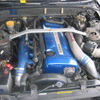What Have You Done To Your Stagea Lately?
Announcements
-
Similar Content
-
Latest Posts
-
Thanks, I removed the fuse and the relay from the car and made my own circuit with them to test them with a test bulb. I will look for the wiring diagram and go from there.
-
Jdm DC2R is also nice for a FF car compared to the regular hatches of the time.
-
By joshuaho96 · Posted
Now that the break-in period for both clutch and transmission is nearly over I'd like to give some tips before I forget about everything that happened, also for anyone searching up how to do this job in the future: You will need at least 6 ton jack stands at full extension. I would go as far as to say maybe consider 12 ton jack stands because the height of the transmission + the Harbor Freight hydraulic platform-style transmission jack was enough that it was an absolute PITA getting the transmission out from under the car and back in. The top edge of the bellhousing wants to contact the subframe and oil pan and if you're doing this on the floor forget about trying to lift this transmission off the ground and onto a transmission jack from under the car. Also do not try to use a scissor jack transmission lift. You have to rotate the damn thing in-place on the transmission jack which is hard enough with an adjustable platform and a transmission cradle that will mostly keep the transmission from rolling off the jack but on a scissor lift with a tiny non-adjustable platform? Forget it. Use penetrating oil on the driveshaft bolts. I highly recommend getting a thin 6 point combination (box end + open end) wrench for both the rear driveshaft and front driveshaft and a wrench extension. These bolts are on tight with very little space to work with and those two things together made a massive difference. Even a high torque impact wrench is just the wrong tool for the job here and didn't do what I needed it to do. If your starter bolts aren't seized in place for whatever reason you can in fact snake in a 3/8 inch ratchet + 6 point standard chrome socket up in there and "just" remove the bolts for the starter. Or at least I could. It is entirely by feel, you can barely fit it in, you can barely turn the stupid ratchet, but it is possible. Pull the front pipe/downpipe before you attempt to remove the transmission. In theory you don't have to, in practice just do it. When pulling the transmission on the way out you don't have to undo all the bolts holding the rear driveshaft to the chassis like the center support bearing and the rear tunnel reinforcement bar but putting the transmission back in I highly recommend doing this because it will let you raise the transmission without constantly dealing with the driveshaft interfering in one way or another. I undid the bottom of the engine mount but I honestly don't know that it helped anything. If you do this make sure you put a towel on the back of the valve cover to keep the engine from smashing all the pipes on the firewall. Once the transmission has been pulled back far enough to clear the dowels you need to twist it in place clockwise if you're sitting behind the transmission. This will rotate the starter down towards the ground. The starter bump seems like it might clear if you twist the transmission the other way but it definitely won't. I have scraped the shit out of my transmission tunnel trying so learn from my mistake. You will need a center punch and an appropriate size drill bit and screw to pull the rear main seal. Then use vice grips and preferably a slide hammer attachment for those vice grips to yank the seal out. Do not let the drill or screw contact any part of the crank and clean the engine carefully after removing the seal to avoid getting metal fragments into the engine. I used a Slide Hammer and Bearing Puller Set, 5 Piece from Harbor Freight to pull the old pilot bearing. The "wet paper towel" trick sucked and just got dirty clutch water everywhere. Buy the tool or borrow it from a friend and save yourself the pain. It comes right out. Mine was very worn compared to the new one and it was starting to show cracks. Soak it in engine oil for a day in case yours has lost all of the oil to the plastic bag it comes in. You may be tempted to get the Nismo aftermarket pilot bearing but local mechanics have told me that they fail prematurely and if they do fail they do far more damage than a failed OEM pilot bushing. I mentioned this before but the Super Coppermix Twin clutch friction disks are in fact directional. The subtle coning of the fingers in both cases should be facing towards the center of the hub. So the coning on the rearmost disk closest to the pressure plate should go towards the engine, and the one closest to the flywheel should be flipped the other way. Otherwise when you torque down the pressure plate it will be warped and if you attempt to drive it like this it will make a very nasty grinding noise. Also, there is in fact an orientation to the washers for the pressure plate if you don't want to damage the anodizing. Rounded side of the washer faces the pressure plate. The flat side faces the bolt head. Pulling the transmission from the transfer case you need to be extremely careful with the shift cover plate. This part is discontinued. Try your best to avoid damaging the mating surfaces or breaking the pry points. I used a dead blow rubber hammer after removing the bolts to smack it sideways to slide it off the RTV the previous mechanic applied. I recommend using gasket dressing on the OEM paper gasket to try and keep the ATF from leaking out of that surface which seems to be a perpetual problem. Undoing the shifter rod end is an absolute PITA. Get a set of roll pin punches. Those are mandatory for this. Also I strongly, strongly recommend getting a palm nailer that will fit your roll pin punch. Also, put a clean (emphasis on clean) towel wrapped around the back end of the roll pin to keep it from shooting into the transfer case so you can spend a good hour or two with a magnet on a stick getting it out. Do not damage the shifter rod end either because those are discontinued as well. Do not use aftermarket flywheel bolts. Or if you do, make sure they are exactly the same dimensions as OEM before you go to install them. I have seen people mention that they got the wrong bolts and it meant having to do the job again. High torque impact wrench makes removal easy. I used some combination of a pry bar and flathead screwdriver to keep the flywheel from turning but consider just buying a proper flywheel lock instead. Just buy the OS Giken clutch alignment tool from RHDJapan. I hated the plastic alignment tool and you will never be confident this thing will work as intended. Don't forget to install the Nismo provided clutch fork boot. Otherwise it will make unearthly noises when you press the clutch pedal as it says on the little installation sheet in Japanese. Also, on both initial disassembly and assembly you must follow torque sequence for the pressure plate bolts. For some reason the Nismo directions tell you to put in the smaller 3 bolts last. I would not do this. Fully insert and thread those bolts to the end first, then tighten the other larger pressure plate bolts according to torque sequence. Then at the end you can also torque these 3 smaller bolts. Doing it the other way can cause these bolts to bind and the whole thing won't fit as it should. Hope this helps someone out there.
-







Recommended Posts
Create an account or sign in to comment
You need to be a member in order to leave a comment
Create an account
Sign up for a new account in our community. It's easy!
Register a new accountSign in
Already have an account? Sign in here.
Sign In Now